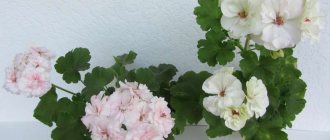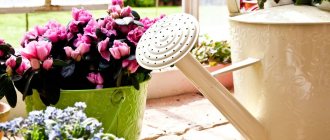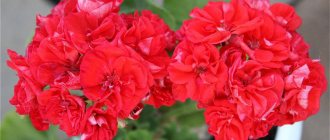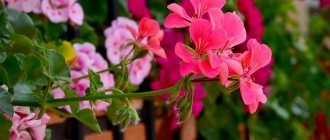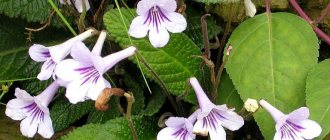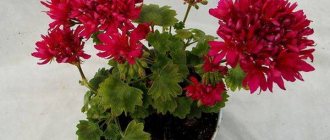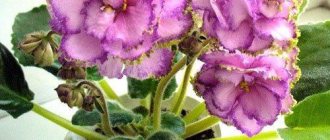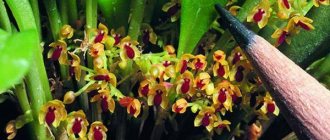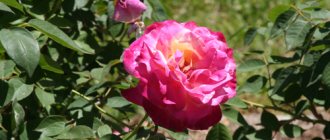PAC Viva Carolina: brief description and features of the variety
The PAC Viva Carolina variety grows in a cascade, growing long spreading branches.
The height of an adult plant varies between 15-25 cm, while the shoots themselves can reach 1.5 m, depending on the method of formation. The green mass is similar to ivy leaves - dark green, with a characteristic glossy sheen and fleshy structure. Pelargonium PAK Viva Carolina produces densely double flowers, the color of which changes as they bloom. White buds appear first; as they open in sunny conditions, the “skirt” acquires a pink tint. After complete dissolution, you can notice a greenish center, due to which the flower seems to glow from the inside.
For young plants, not very abundant flowering is typical - a maximum of 5-7 flowers open in each cap, but as the bush matures, their number increases. The inflorescences are dense, full and completely cover the crown, making pelargonium look elegant and impressive.
It is worth noting that Viva Carolina belongs to compact varieties with short internodes, which provide decorative crown at each stage of the growing season. With age, the quality of flowering improves, the buds become larger, brighter and fuller. Pelargonium does not fall off - the flowers simply dry out on the peduncles, turning into a herbarium.
The average recommended pot volume should not exceed 1.5 liters; in addition, the plant needs proper wintering. It propagates vegetatively, but it is better to root the cuttings immediately in light soil without first germinating in water, since the cut can rot from too much moisture. It is advisable to pinch the bush at all stages of maturation - pelargonium left unattended can become deformed and grow undecorative lashes.
Viva Rosita: a brief description of pelargonium
Photo:
The PAK Viva Rosita variety, bred by a Swedish nursery in 2011, immediately attracts attention with its luxurious flowers. The shape and layering of the petals is as close as possible to Old English roses
The color of the buds is bright crimson and in contrast with the green foliage this color looks very impressive
The shape and layering of the petals is as close as possible to Old English roses. The color of the buds is bright crimson and in contrast with the green foliage this color looks very impressive.
Viva Rosita is very generous with its inflorescences, forming from 20 to 30 buds, which bloom gradually. Young bushes often dry out some of the flowers, but in adulthood the problem disappears when the plant gains strength.
The budding period lasts about 2 weeks, pelargonium forms thick and strong peduncles. Since the flowers are not close to each other, they are easy to see individually.
Viva Rosita forms a compact and lush crown independently, without outside intervention.
Often, one pinching is enough for the crown to begin to branch; in some cases, you can do without manipulating the shoots.
With sufficient lighting, a dark semi-ring is formed on the leaves - a “zone”, which makes pelargonium even more decorative.
PAC Viva Rosita is an easy and trouble-free variety to propagate; to obtain new bushes, it is enough to remove the required number of shoots from the mother plant and root them in a light and loose substrate.
Pelargonium reacts positively to annual transplants; it is better to use a pot a couple of centimeters larger than the previous one.
During the budding period, Viva Rosita geranium needs regular feeding and abundant watering - such care will allow the plant to reach its maximum potential.
At the end of autumn, it is advisable to send pelargonium for the winter, which promotes proper rest and the formation of flower buds for the next season.
Features of appearance, description and photos of common types
This variety of pelargonium is completely different from its counterparts. It looks more like double Asian buttercup or red roses. One inflorescence can contain from 5 to 30 flowers. Each bud is approximately 5-6 centimeters in diameter.
The buds in each brush do not fit each other very tightly, due to this you can easily examine each flower individually. The peduncle grows quite slowly, but this is further justified by the long flowering period - usually the blooming buds stay on the plant for up to 15 days.
Gardeners like the bush for its compactness. The branches extend from it often and densely. The leaf blades are very dense, even a little harsh, and they are very rich in color - dark green. With a large amount of lighting, the leaves on the plant become even larger and they look more luxurious; with the amount of foliage, the number of peduncles also increases.
We invite you to familiarize yourself with the descriptions and photos of the most common varieties of Viva pelargonium.
Caroline
This plant is distinguished by lilac-white petals. They feel terry to the touch, the flowers grow very densely on the bush. From 3 to 5 single flowers are formed on one flower brush. The leaf blades are, as usual, dark green and differ in their growth in width. The flowering period is considered long, and the process itself occurs very abundantly.
Madeleine
The variety is distinguished by the correct shape of the bush and a long period of budding. The foliage is wide, but we are not talking about large sizes here. The leaf color is dark green. This variety is considered a zonal variety. The shade of the petals is usually white, but blush appears in the sun.
Rosita
Flower petals are bright pink. The foliage is green, but not dark. Approximately 5-6 buds can form on one inflorescence. During the flowering period, which lasts about 15 days, the flowers delight with their brightness and splendor.
General information
This plant was first bred by breeders from Sweden, who soon after brought their brainchild to a European exhibition. There, pelargonium caused a great stir, which led to a flurry of positive reviews. This exquisite flower has become a multiple winner at various flower festivals, including in the capital of Russia, where it was brought in 2012.
The inflorescences of the PAC Viva variety have similar external features to rose buds and a flower such as ranunculus (a special type of buttercup). The surface of the petals resembles terry to the touch. The number of flowers on one umbrella can vary from 6 to 30 pieces. The size of an individual flower is about 5 centimeters. The arrangement of the buds in the inflorescence is quite free, which makes it easy to view each flower in the umbrella.
The growth of the inflorescence itself can occur over quite a long time. However, when the buds bloom, they will be able to delight you with their luxurious blooms for two weeks, and sometimes a little longer.
The plant itself is small, it is not a hanging plant, so it will not spread its branches to the sides. They grow quite close to each other. The leaves are hard in texture and rough to the touch. Their color is dark shades of green. Observing a plant that is in a well-lit room, it will become noticeable that its foliage is replenished with even more new leaves. Consequently, an increase in the number of leaves will be followed by an increase in the number of inflorescences. The flower will become even richer and more beautiful to look at.
How to grow ivy-leaved pelargonium
Proper cultivation of the PAC Viva Carolina variety lies in properly selected maintenance conditions, which consist of several points:
- Good lighting. Southern window sills or bright loggias and balconies are preferable. It is better to shade the bush from direct sunlight to prevent burns of the deciduous mass;
- Temperature. The optimal temperature range is +20-+25 degrees during active vegetation and flowering, about +14 during the wintering period;
- Humidity. There is no need to create “tropical” conditions for ivy-leaved pelargonium - a plant with African roots tolerates low humidity and mild drought. It is not recommended to allow the leaves to come into contact with water, since in this case the plant experiences stress.
Pelargonium agricultural technology comes down to compliance with the following rules:
- Moderate watering. PAK Viva Carolina tolerates drought well, but you should not allow the soil to dry out too much - this will inevitably affect the quality of flowering and the decorative appearance of the crown. Flooding the soil is also undesirable, as it leads to rotting of the roots;
- Feeding. Indoor cultivation of varietal pelargoniums requires the mandatory use of fertilizers for Geraniums with a high content of potassium and phosphorus. The compositions are applied during the active growing season once a week; with active growth of the bush, more frequent application of fertilizing is allowed. During the dormant period, the plant is not fertilized;
- Transfer. The plant must be replanted into a new pot annually, using small flowerpots (the maximum distance between the root system and the walls of the container is 1.5-2 cm). It is imperative to use drainage to prevent moisture stagnation at the roots, as well as the use of a loose and nutritious substrate in which Viva Carolina can develop normally. Ideally, the soil will include peat, turf and leaf soil, sand or perlite, humus in equal quantities, as well as a small part of charcoal or activated carbon.
The PAK Viva Carolina variety feels great in the fresh air - with the onset of summer, hanging flowerpots can be hung on the balcony to create a decorative area. The only caveat: the bush needs to be accustomed to “street” maintenance gradually so that pelargonium can acclimatize normally without stress. With the onset of cold weather, the flowerpots must be brought back indoors to avoid freezing.
Wintering of PAC Viva Carolina should take place in a dry room at a stable temperature of about +14-+15 degrees. The plant is prepared for a dormant period 30 days in advance, completely stopping feeding, and then transferred to a well-lit, cool windowsill. Watering is carried out rarely and in small portions, since under these conditions the bush does not need a significant amount of moisture. In the second half of February, pelargonium is returned to its usual conditions of detention, if necessary, pruned and shaped, replanted and fertilizing is resumed.
Pruning is a necessary measure to preserve the decorative appearance of the bush, while the main attention should be paid to pelargonium in the fall. The axillary shoots are greatly shortened, leaving about 7 leaves, all bare and dry branches are completely removed
The crown is formed throughout the growing season, promptly removing dried inflorescences and thinning the bush.
In general, caring for the Viva Carolina variety cannot be called difficult - growing pelargonium requires minimal expenses from the grower. Care always pays off with beautiful and lush flowering within several months.
Pelargonium viva madeline
Many housewives love to decorate their interiors with indoor plants, especially those that produce beautiful blooms. The indoor pelargonium flower PAC Viva is just one of these.
It is simply impossible to pass by such a flower; its delicate buds will definitely make you look at them. It is thanks to its elegant flowering, as well as its ease of home care, that pelargonium can often be found in homes.
In addition, she has been pleasing housewives with the beauty of her inflorescences for a long time.
General information
This plant was first bred by breeders from Sweden, who soon after brought their brainchild to a European exhibition. There, pelargonium caused a great stir, which led to a flurry of positive reviews. This exquisite flower has become a multiple winner at various flower festivals, including in the capital of Russia, where it was brought in 2012.
This variety of pelargonium differs from others in its numerous voluminous flowers, collected in separate umbrellas on a stalk.
The inflorescences of the PAC Viva variety have similar external features to rose buds and a flower such as ranunculus (a special type of buttercup). The surface of the petals resembles terry to the touch.
The number of flowers on one umbrella can vary from 6 to 30 pieces. The size of an individual flower is about 5 centimeters.
The arrangement of the buds in the inflorescence is quite free, which makes it easy to view each flower in the umbrella.
One of the advantages of PAC Viva pelargonium is its long flowering.
The growth of the inflorescence itself can occur over quite a long time. However, when the buds bloom, they will be able to delight you with their luxurious blooms for two weeks, and sometimes a little longer.
The plant itself is small, it is not a hanging plant, so it will not spread its branches to the sides. They grow quite close to each other. The leaves are hard in texture and rough to the touch. Their color is dark shades of green.
Observing a plant that is in a well-lit room, it will become noticeable that its foliage is replenished with even more new leaves. Consequently, an increase in the number of leaves will be followed by an increase in the number of inflorescences.
The flower will become even richer and more beautiful to look at.
Varieties
Breeders at one time were not too lazy to create several types of such a beautiful flower as pelargonium PAC Viva, and, undoubtedly, they only benefited from this. Each of these types has its own individual characteristics, a detailed description of which is given below.
- PAC Viva Carolina . A flower of this species pleases us with large buds, the color of which is a combination of white and pale lilac. Densely growing inflorescences have a fleecy surface. There are about 5-6 flowers on one umbrella. An adult healthy representative of this species is distinguished by rich flowering. The leaves have a color typical of PAC Viva pelargonium - rich green.
- PAC Viva Madeleine. This pelargonium is the most compact of all PAC Viva varieties. Its leaves are not as large as, for example, “Carolina”, and the color is dark green. The outlines of the bush have a neat shape. PAC Viva Madeleine blooms in much the same way as other representatives of the variety. The flowers are white, with a slight pinkish tint.
- PAC Viva Rosita. From the name of the species you can understand what color the petals of pelargonium are - bright pink or coral. The leaves of "Rosita" have a lighter shade than all the others. The plant stands out for its splendor and density of flowering. One inflorescence has about 5-7 flowers. When the buds open, pelargonium looks simply amazing.
This flower will be a bright addition to the design of any room.
- PAC Viva Maria. A special feature of pelargonium “Maria” is the unusual color of the buds, which combines white and rich pink. The petals, white at the base, become bright pink closer to the middle. The medium-sized leaves have a rich green color. Pelargonium blooms for a period of fifteen days, has a rich color, while maintaining a neat appearance.
Growing and care process
Those who want to buy this elegant flower for themselves need to know that it is more profitable to buy not a young plant (its cost will range from 500 to 800 rubles, depending on the manufacturer), but a pelargonium shoot, growing which at home will not cause big problems , subject to the following tips.
- Pelargonium PAC Viva of any variety is grown at home from late autumn to early spring. This is due to the fact that plant development must occur at a time when the day begins to get longer.
- For planting, you need a special soil mixture, which can be purchased ready-made in gardening stores. You can also make it yourself by purchasing the components separately: turf, organic rock (peat) and sand. The proportion should be maintained as follows: 2: 1: 1. Mix all the ingredients and pour into the prepared container.
- If seeds are used for propagation, they are planted in an oblong container. The grains are arranged so that there is a gap of about 4-5 centimeters between them, and they are covered with earth on top. The soil is moistened with a sprayer containing water that was previously settled. After this, the tray with the seeds is covered with cling film, which is opened every day so that the seeds can be saturated with oxygen.
- To plant cuttings, you should use containers with a small volume. We place the cutting in the pot, after which we moisten the soil with settled water; there is no need to cover it with anything. The shoot requires constant lighting and regular watering. As soon as the young plant begins to develop a root system, we transplant it into a looser pot, proportional in length and width.
An adult pelargonium PAC Viva does not require constant attention. Caring for this plant is limited to regular watering, spraying, and a properly selected corner in the room.
Contrary to the fact that other varieties of pelargonium love light, this species prefers not too bright lighting. It is better to choose the shady part of the room.
As soon as the weather allows, the plant can be taken out to the balcony or loggia so that it is saturated with oxygen.
There is no need to water pelargonium often, as this can cause the roots to begin to rot. It will be enough to moisten the soil as soon as it begins to dry out.
It is best to choose drainage pots for planting, which will help not retain water in the soil. It would be more correct to place a tray with water under the flower. Thus, the root system of the plant will always be supplied with the necessary amount of moisture.
In order for the flower to develop well and bloom luxuriantly, it is necessary, among other things, to adhere to a moderate temperature regime - 22-26 degrees. In spring and summer, you need to place pelargonium in the open air, and in winter, remove it from places where there may be cold or wind.
The moisture level in the room must be kept at an average level. Periodically, you need to open the windows to allow fresh air to enter the room, this is the prevention of parasites and diseases.
Additionally, there is no need to use a sprayer with water, only in case of extreme dry air.
For better penetration of oxygen into the soil, it should be loosened regularly. Pelargonium needs to be actively fed from the beginning of spring until late autumn. The necessary fertilizer mixtures can be purchased in specialized stores.
In spring and autumn, you need to spray the flower with fertilizers about a couple of times a month. In winter, it is better to avoid feeding altogether. In winter, the plant is placed in a darker place, and the watering regime is reduced to once a week and a half.
It is better to place pelargonium in a room with a temperature below 20 degrees (15-18 would be optimal).
Portal about construction
Source: https://flor-amore.ru/komnatnye-tsvety/pelargoniya-viva-madelina.html
Pelargonium PAC Salmon Komtess - what kind of hybrid variety is it
Flowers arrived from South Africa to European countries along with sailors in the 16th century. Breeders worked on improvements, as a result of which unpretentious varieties of the Geraniaceae family were obtained.
What pelargonium PAC Salmon Komtess looks like
Brief description and origin story
Pelargonium Pak Salmon Comtesse is a hybrid obtained in the German nursery PAC Elsner. He specializes in growing plants suitable for landscaping apartments, houses and streets. Their specimens are distinguished by increased resistance to adverse conditions and beauty.
The description contains the following information:
- average bush size - from 25 to 35 cm;
- the bushes are harmoniously folded, without excessive stretching;
- dark green foliage;
- Large double flowers with a soft pink color, they are collected in umbrella inflorescences located on vertical peduncles.
In the summer months, Salmon pelargonium grows calmly in open ground and is not afraid of cold temperatures down to −7 °C.
For your information! Frost-resistant varieties are more often used in landscape design.
Medicinal properties
Pelargonium Priory Salmon has the ability to improve the indoor microclimate. Due to the phytoncides included in the composition, the plant eliminates harmful bacteria, purifying the air.
Important! The main effect of the active components is considered to be the antiviral and antibacterial spectrum. They are able to cope with staphylococcal infections that cause serious illness
Pelargonium Queen purifies the air in the room where it grows
Diseases and pests, combating them
The flower is quite resistant to diseases and is not capricious. The most common reasons for the poor state of culture:
- improper watering or air humidity;
- virus infection;
- attacks by mites, aphids and caterpillars;
- bacterial infections.
The main way to prevent problems is timely care and maintenance, and treatment is carried out by carefully removing diseased leaves. New shoots will appear in their place.
Odensjo Symfonia pelargonium is distinguished not only by its amazing flowers that can delight almost the whole year, but also by its original aroma. This unpretentious and at the same time beautiful flower was a favorite of aristocrats in the 18th century.
Diseases and pests
Pelargonium has high immunity, so pests and diseases rarely bother it. But if not properly cared for, problems can still arise.
Blooming Pelargonium Hilda
If the plant is in the wrong place or has an incorrect watering schedule, this is indicated by the following signs:
- lack of flowering;
- rusty or dried leaves;
- rotting of the root system.
It is necessary to immediately eliminate the cause of the disease and treat the plant with fungicides.
In some cases, aphids, mealybugs or whiteflies may appear on the bush. When they are detected, the flower is sprayed with insecticides.
With proper care, pelargonium will become an excellent ornamental plant with bright, unusual flowers.
Planting Pelargonium Lake
Lake - pelargonium is unpretentious, but it is important to choose optimal conditions for the plant
Choosing a place and pot
Like all house geraniums, Laque prefers light areas on the south side
However, it is very important to protect the “green pet” from direct UV rays by lightly shading with tulle. A draft is unacceptable, but the crop loves fresh air, so constant ventilation must be ensured.
The pot should be selected based on the size of the bush, taking into account the fact that this geranium does not like “relocation”. Rounded models up to 15 cm in diameter and up to 20-30 cm in height look beautiful. But these dimensions are relevant for an adult plant. To plant the cuttings, you can choose a regular plastic cup.
Note! The diameter of the container should not be too large, otherwise pelargonium will begin to develop a root system, which will affect the green mass and flowering
A very beautiful plant will certainly respond to proper care and will thank the grower with stunning caps of inflorescences
Priming
A drainage layer is required, for example, from gravel, expanded clay, vermiculite. It will help prevent the roots from rotting. You can buy ready-made soil for geraniums. Or mix it yourself from turf, humus and coarse river sand.
How to properly care?
To care for the plant, the following factors must be taken into account:
- Temperature conditions. The most common temperature is from 18 to 25 degrees. The flower does not like overheating and direct sunlight, which lead to burning of the leaves, their dryness and subsequent falling off.
- Watering. Water the plant only with settled or filtered water; preferably, the water should be at room temperature. The plant should be watered as the soil dries; do not overwater the flower, as this can lead to rotting of the root system. In summer, watering should be more abundant and regular; in winter it should be reduced, since the flower is dormant.
- Feeding. It is necessary to apply mineral fertilizers, which must be alternated with organic fertilizer. In summer, fertilizing should be done once every week and a half. In winter, fertilization should be reduced to once a month or once every six months.
- Humidity. Geranium loves fairly humid air, so you can place a container of water next to the plant and regularly spray the leaves and flowers.
Features of reproduction
The propagation process occurs by cuttings. Ready-made cuttings can be purchased at a nursery or flower market. When planting, do not overwater the flower, otherwise it will die. Propagation by cuttings is carried out in February-March or August-September.
Pelargonium Viva is an ornamental crop that even a child can care for. This flower blooms profusely and luxuriantly both on the balcony and on the windowsill. And in order to prolong this flowering for the maximum period, the task of each gardener comes down to creating adequate growing conditions.
dacha.expert
How to properly care?
Viva is undemanding in terms of care, but there are a number of requirements:
- Watering. Moisturize pelargonium infrequently. Just make sure its roots don't dry out. To grow a flower, use containers with holes in the bottom. Watering should be done directly from the bottom, then the roots themselves will be able to take the moisture necessary for the plant. Do not use external watering or irrigation, as this can damage the integrity of the leaves and flowers.
- Temperature conditions. For full and comfortable growth of the plant, you need to grow it in a room with a temperature of 20-25 degrees Celsius. If possible, you should take the plant outside.
- Air humidity. Successful cultivation of pelargonium does not allow too much humidity. It should be 65%. Ventilate the room regularly to avoid the development of unpleasant situations.
- Loosening the soil. These activities are required when growing Viva pelargonium. Then oxygen will penetrate into the soil, and water will be able to leave without stagnating in the root system.
- Fertilizer. In spring and summer, during the active flowering of the plant, add special mixtures of nitrogen, potassium and phosphorus to the soil. Such events are held 2 times a month. You can purchase fertilizers in specialized stores.
- Winter care. It is not much different from the standard one. Move the container with the flower to a shaded place where the temperature is 15 degrees Celsius. Water the plant 2 times a month. It is not recommended to feed the pelargonium; it is enough to feed the pelargonium once in the fall.
Diseases and pests
Most often, the following ailments can be noticed on Viva pelargonium:
- Fungus Puccinia. It is distinguished by red pigmentation on any part of the plant. As soon as a lot of spots appear, the affected parts fall off, and the whole plant begins to dry out. Fungicides help fight this disease.
- Blackleg. You can recognize it by the characteristic blackening at the base of the shoot, which is caused by a fungal infection. It can also be treated with fungicides; resuscitation should begin as early as possible so that the disease does not spread further throughout the plant.
- Gray rot. This disease can be recognized by its characteristic plaque. The cause is cool and damp air. It is treated by changing the growing conditions - ensuring good ventilation and increasing the air temperature.
- Nematode. This disease affects the root system, causing the entire plant to die. There are no methods for treating such a disease, so if a nematode is detected, you will have to say goodbye to pelargonium.
- Swelling of foliage. It manifests itself in the form of small growths on the leaf plates. It develops due to lack of lighting and too much soil moisture. To get rid of swelling, you should change the soil or simply dry it well. It is better to put a new drainage layer.
Pelargonium Viva can be attacked by the following parasites:
You can get rid of pests using drugs that have proven to be the most effective.
Description of varieties
Among the varieties of pelargonium of the Elnaruds series, there are the most common ones.
Hilda
Compact pelargonium with lush double buds of uneven pink and white color. The leaves are yellow with a brown spot in the middle. Hilda tolerates heat well and has a long flowering period.
Gusten
A vigorously flowering variety of pelargonium Elnaryds. The inflorescences are dense, the buds are peachy-pink. The bush has a compact shape.
Variety Gusten
Bente
Zonal pelargonium. It reaches a height of 10 cm. The inflorescences are lush and double. The buds are apricot-red. Flowering of this species begins in May and continues until the end of September.
Bente flower
Otto
Otto is often used to decorate balconies and verandas. The buds of this variety are orange in color, gradually turning into soft pink. The bush reaches a height of 10 cm. Flowering begins in late spring.
A variety of flower called Otto
Singoalla
House plant with white, slightly pinkish flowers. The bush is compact and easy to shape.
Pelargonium Singoalla
Lilian
A dwarf plant with double voluminous inflorescences. The buds can be bluish-lavender in spring and pink in summer.
Representative of the Lilian variety
Clarissa
Lush bush with snow-white double flowers. The plant is compact and does not require formation.
Clarissa flower
Features of plant flowering
Ampelous pelargonium or geranium - growing and care at home
The plant is distinguished by lush and abundant flowering. It can be used to decorate any room.
- Period of activity and rest
The flowers are on strong peduncles. They have 15-20 buds. Flowering lasts from May to October. After which comes a period of rest. This time is characterized by a slowdown in many processes inside the pelargonium bush, so excess watering and fertilizing will not be beneficial.
- Types and shape of flowers
The flowers are shaped like double peonies or ranunculus. Pelargonium petals are folded in several layers.
About the beneficial properties of pelargonium
Homemade varieties of pelargonium are interesting for their varied effects on human bodies. For some, when in close proximity to a flower, the general condition of the body noticeably worsens, while for others, its smell has a relaxing and calming effect.
In addition to decorative properties, pelargonium is also endowed with useful properties: extracts from it are widely used in the perfume industry, as well as to create a variety of medical preparations.
Pelargonium essential oil is added as a flavoring agent in soap making and to create perfumes of very famous brands. The oil is also used to disinfect indoor air. Its aroma does an excellent job of eliminating various microorganisms and purifies oxygen from impurities harmful to the human body.
Other varieties of PAC Viva
The abundance of crop varieties allows everyone to choose the color tone they like. Although they are prized for their colorful buds, there are also specimens with very beautiful foliage.
Note! The buds of this variety look like roses, but there are also tulip-shaped varieties in the family. For example, pelargonium PAK Salmon Princess (Princess Caroline pelargonium)
PAC Viva Madeleine
Pelargonium PAC Viva Madeleine is a fairly compact bush with a long flowering period. In partial shade the petals are snow-white, but in full sun they turn pink. The leaves are small, dense green.
PAC Viva Rosita
The pelargonium variety Pac Viva Rosita blooms luxuriantly. The buds, collected in inflorescences, bloom bright scarlet petals. Flowering lasts about half a month. This variety is most often chosen for home collections.
Important! It takes root well from cuttings, so there is no need to spend money on an adult bush.
PAC Viva Maria
Pelargonium Pac Viva Maria is distinguished by the size of its buds. It is covered with large double flowers. The color of the petals is peculiar; they are pearl pink with deep crimson markings in the center. Because of them, Viva Maria is called the little eye.
Varieties
Breeders at one time were not too lazy to create several types of such a beautiful flower as pelargonium PAC Viva, and, undoubtedly, they only benefited from this. Each of these types has its own individual characteristics, a detailed description of which is given below.
PAC Viva Carolina. A flower of this species pleases us with large buds, the color of which is a combination of white and pale lilac. Densely growing inflorescences have a fleecy surface. There are about 5-6 flowers on one umbrella. An adult healthy representative of this species is distinguished by rich flowering. The leaves have a color typical of PAC Viva pelargonium - rich green.
PAC Viva Madeleine. This pelargonium is the most compact of all PAC Viva varieties. Its leaves are not as large as, for example, “Carolina”, and the color is dark green. The outlines of the bush have a neat shape. PAC Viva Madeleine blooms in much the same way as other representatives of the variety. The flowers are white, with a slight pinkish tint.
PAC Viva Rosita. From the name of the species you can understand what color the petals of pelargonium are - bright pink or coral. The leaves of "Rosita" have a lighter shade than all the others. The plant stands out for its splendor and density of flowering. One inflorescence has about 5-7 flowers. When the buds open, pelargonium looks simply amazing.
PAC Viva Maria. A special feature of pelargonium “Maria” is the unusual color of the buds, which combines white and rich pink. The petals, white at the base, become bright pink closer to the middle. The medium-sized leaves have a rich green color. Pelargonium blooms for a period of fifteen days, has a rich color, while maintaining a neat appearance.
PAC Viva Rosita care
The container for planting PAC Viva Rosita geraniums should be large enough, at least 2 liters. Its root system does not tolerate constraint. In pots with a smaller volume, Viva Rosita dries out the buds and noticeably slows down the growth process.
This variety, unlike the prevailing opinion that pelargoniums love open sun, does not tolerate constant heat and excessive heating of the soil coma. Ideal for it would be a window sill facing east or southwest. But even here it will be necessary to take care of organizing shading from direct rays.
With the arrival of the warm season, it is better to move geraniums (if possible) to the open air. In the shade of deciduous trees on a personal plot, it will bloom and develop much better.
Regarding the temperature regime in apartment conditions, in summer you need to make sure that the temperature does not exceed 30C, and in winter, in order to ensure abundant flowering, it should be relatively low and not exceed 14C.
Viva Rosita geraniums should be watered sparingly. Each subsequent watering is carried out only after three days after the top layer of the earth has dried. These recommendations apply exclusively to the summer period. Winter watering is carried out only when the soil begins to dry out slightly.
With high humidity and low temperature in the room, the root system of the plant may begin to rot. This can have a very negative impact on the general condition of the geranium and can lead to the onset of various diseases or even its death.
It is not worth spraying pelargonium regularly throughout the year. It tolerates dry air well. But, in cases of too hot summer and, accordingly, an excessive increase in room temperature, the foliage will not have to be moistened much.
The plant needs to be fed, but only after several months after transplantation, a maximum of two times with an interval of a couple of weeks.
For feeding, you can use only phosphorus fertilizers. Adding organic compounds to the soil has no benefit, since geranium does not accept them.
Pruning and replanting
Viva Rosita growing indoors is pruned every year, leaving shoots with a maximum of 4 nodes untouched. This gives owners the opportunity to have a rather lush and beautifully flowering bush on their windowsill. If yellowed or dried leaves are found on the bush, they are carefully cut off. They perform the action exclusively with a well-sharpened knife.
Viva Rosita needs to be replanted: young plants annually, and adults only when the root system completely fills the planting container.
At each transplant, drainage is placed at the very bottom of the pot, and then filled to the top with the following mixture: peat, turf, sand, humus and leaf soil. All listed ingredients must be in equal parts.
Find out all the secrets of growing indoor geraniums, watch this interesting video:
Julia, yudina10
- thank you for your kind words!:) I just love them very much and for a long time
Irina (sunfly)
, yes, she is good!
There’s nothing you can say against it.. I’ll tell you about the pot like this - it’s terracotta, the real thing.. Thick-walled, as they say, triple fired.. I once wrote about them.. Now, unfortunately, they are not available you'll meet... And before they were sold in sizes from small to large. German ancient manufactory. OBI sells similar ones in forms, but the quality is like heaven and earth. And, in fact, the manufacturer is different, of course. Era's Ylva
is a wonderful variety. The shade is light, lilac... Clean! Very handsome. As I said, my plant had to jump from place to place and not always get the sun... And now it stands in sufficient shade... But the potential of the plant, its shape, the desire to be lush, and also flowery, is very captivating... I will say that I am very pleased!
By the way, the pot is large solely for the convenience of caring for my plants in difficult living conditions for them without my constant supervision.
And this star-shaped pelargonium is very good for me this summer.. I couldn’t photograph it successfully, in full bloom.. And today, having visited the dacha, I cleaned the caps.. This year I can’t track it down and catch it..., take a picture at the very best. peak.. I just can’t. But I liked it! Although I somehow have a calm heart for this group. Last year the plant lived in the city, and apparently the fresh air this summer had a beneficial effect. I gave up many of my star-shaped ones, but I’ll keep this one for now..
Priory Salmon
Pelargonium is good both in life and in photos. They say that it’s better to take pictures in cloudy weather.. But I’m so drawn to do it in the sun.. As my son says, that I’m catching him :) So be it..:)
Thank you very much for your detailed answer.
Further care
Caring for pelargonium is not difficult even for an inexperienced gardener. It consists of timely moderate watering and loosening of the soil. Drying out of the soil or stagnation of excess water should not be allowed. Excessive watering can lead to root rot. The variety does not require spraying of leaves or additional air humidification.
Pelargonium grows independently with one stem. To give the bush a beautiful shape, pruning should be done. Then several new shoots will grow from each stem at once, and the plant will take on a beautiful shape.
Formed flower on the windowsill
With the onset of cool days in autumn, pots with plants are moved to a cooler place. The lack of lighting is compensated for by fluorescent lamps, extending the daylight hours to 10-12 hours. The air temperature should not exceed 20 °C.
Important! Fertilizing is done once a month with complex fertilizers for flowering plants.
Features of cultivation and care
Caring for zonal pelargonium is very simple. All you need is to choose a good place for planting and determine the correct watering regime.
Care at home is the most comfortable, since it does not require covering the plant for the winter or controlling rodents. However, there are some nuances here too. For example, if placing pelargonium outdoors in spring and early summer is almost guaranteed to provide the plant with the required amount of light, then indoors you will have to find the brightest and most tranquil corner of the house - preferably a south-east window. If such a place is not found, in winter the flower will have to be illuminated artificially - using lamps.
The home conditions in our regions are ideal for growing zonal pelargonium - comfortable temperatures for the plant are considered to be from 12 to 24 °C, which allows the flower not to fade even in winter. The same applies to humidity: low humidity during the heating season is not a cause for concern, because pelargoniums do not need spraying. All they need is regular watering after the soil dries out. In winter, the frequency of soil moistening can be reduced to once every 10 days.
Zonal pelargoniums prefers loose soils. Special soils for this type of plant can be purchased at a flower shop or mixed yourself. To do this you will need leaf soil, peat, charcoal and sand. All ingredients must be mixed in a ratio of 3:1:1:1.
The flower needs to change the soil once a year. When transplanting from pot to pot, the volume of the new vessel should not exceed the previous one by more than 15%. The plant is planted in the ground in mid-spring and removed from there in the fall.
Pelargoniums are characterized by a high growth rate, which is why the timely formation of a bush becomes an important point. If there is no pruning and removal of old shoots, the plant will stop blooming. Therefore, regularly remove old shoots, and also pinch the flower at growth points no higher than above the sixth leaf.
Pelargonium zonalis, like other house plants, is often affected by pests and fungal diseases. In addition, the cause of disease can be improper care of the flower or its complete absence. To avoid problems, do not disturb the regime of watering, replanting and fertilizing, and also regularly check the plant for the presence of parasites (aphids, whiteflies, spider mites).
Get to know the PAK Viva Rosita variety in the photo:
Planting and replanting Laque pelargonium
Pelargonium Laque does not like dense plantings. When planting it in open ground, do not forget about long roots, the distance between the bushes should be 20-30 cm, holes are dug to a depth of 20 cm. Planting in the soil is done in June, when the soil is no longer subject to frost.
On the windowsills in the apartment it is planted in medium-sized pots, 15-20 cm in diameter. It is better if it is a ceramic pot, it can protect the roots of the plant from high temperatures. In the absence of ceramic pots, you can plant in plastic ones, but be more careful about drying out the soil.
Note! Pelargonium begins to bloom only after the roots of the plant fill all the free space in the pot. Therefore, large containers for plants are not advisable.
Pelargonium prefers light, loose soil with a high content of sand and peat. A lack of nutrients in the soil can slow down the development of a plant and its flowering. A layer of drainage must be poured onto the bottom of the pot. Pelargonium Laque loves sunny areas, but partial shade is still preferable for it. It is advisable that the air temperature does not exceed 20-22 ° C, then flowering will be more abundant.
Important! The sand used for soil should not contain clay inclusions
Landing rules
Landing activities are not particularly difficult:
- Start planting from November to mid-spring. The fact is that as the seedlings grow, the duration of daylight hours gradually increases.
- Prepare soil composition for planting. To do this, combine turf, peat, sand in a ratio of 2:1:1.
- Fill the boxes with the resulting substrate. Plant the grains at a distance of 5 cm from each other.
- Sprinkle with earth, but not in a thick layer. Sprinkle with settled water at room temperature.
- Cover the box with plastic and wait for the first shoots, opening the film every day.
How to care for Millfield Rose pelargonium at home
To achieve success in growing a plant, it needs to be provided with complete and high-quality care.
Illumination and temperature conditions
For the crop, you need to choose the optimal temperature regime. It should be at +20..+27 degrees.
In order for buds to form on the bushes and double inflorescences to appear, the plant requires sufficient daylight hours. It must be at least 14 hours. Sometimes there is a need to use phytolamps. Thanks to this, it is possible to achieve winter flowering of the crop.
With the arrival of warmer weather, the plant can be planted in open soil. For it you need to choose a well-lit place. It is also permissible to take the bushes out onto the balcony or terrace. In this case, you need to ensure that there is partial shade above the plant and the bushes do not get burned.
Watering rules and humidity
Pelargonium needs to be watered abundantly, but it is not recommended to over-moisten the soil. Overdrying the soil clod is also undesirable. In this case, there is a risk of the crop’s leaves falling off, which reduces its decorative properties. Excess moisture provokes rotting of the roots - in such a situation it will not be possible to save the crop.
Water the soil as it dries out. In the winter season, the frequency of soil moisture is significantly reduced, because pelargonium rests.
Important! For watering pelargonium, soft, settled water at room temperature is suitable. Using cold liquid causes rotting of the root system
Spraying the crop is not recommended. In this case, the leaves must be systematically cleaned of dust. A barely damp cloth is suitable for this manipulation. Immediately after the procedure, you should dry the flower in the sun.
For lush, abundant flowering, the crop requires sufficient illumination.
Fertilizing and soil quality
In order for the plant to enjoy lush flowering for as long as possible, the bush needs additional nutrition. Fertilizers should be used very carefully. Excess fertilizer will lead to undesirable consequences.
- In the spring, it is recommended to fertilize this representative of the geraniums with nitrogen agents. Thanks to such preparations, it is possible to achieve an increase in green mass.
- Before the formation of buds begins, nitrogen-containing products are canceled. During this period, the bushes need the use of potassium and phosphorus. Thanks to such substances, beautiful inflorescences are formed.
To feed pelargonium, you can use combined mineral products that are sold in stores - they have a balanced composition.
Flower container size
A medium-sized pot is suitable for pelargonium. A container that is too spacious leads to active growth of the bush. In this case, flowering can be very sparse.
As the culture develops, select a larger container and replant the Millfield Rose pelargonium.
Pruning pelargonium
To get a beautiful compact plant, it needs to be pruned occasionally. The procedure promotes abundant flowering and rejuvenation of the crop. The development of shoots should be monitored throughout the growing season. With the onset of autumn, anti-aging pruning is performed. In this case, you need to remove old and diseased branches.
This is interesting! There is another very similar plant variety - pelargonium Millfield gem. But this culture is characterized by completely double inflorescences.
Varieties of indoor plants with names
This group of pelargoniums includes several varieties. They all differ from each other in the shape of flowers and leaves, color. The most popular varieties bred by Yu. Gonchar are described below.
SOUTH-Shukar
This spectacular variety belongs to the group of zonal pelargoniums. The flowers are ordinary or double, which have a cherry-scarlet hue. The plant needs regular pruning, otherwise it will lose its decorative shape. Pelargonium foliage is rich green.
SOUTH-Jadwiga
Pelargonium South-Jadwiga is a strong compact bush, literally strewn with bright pink flowers. The plant does not require formation; in itself it is quite neat. Jadwiga leaves are ordinary green.
SOUTH-Varvara beauty
YUG-Varvara Krasa is a pelargonium, which is called one of the most compact among those bred by Yu. Gonchar. The bush has the correct shape, it is neat and dense. It doesn't require formation. Terry buds of a delicate pink shade are more like miniature roses or peonies rather than geraniums.
The lush inflorescences of this pelargonium resemble tiny bridal bouquets
Note! If the pelargonium Varvara Krasa has enough sunny color, the color of its petals becomes brighter
SOUTH-Sakura
It’s easy to guess that this variety got its name due to its amazing similarity to Japanese cherries. The flowers are characterized by a light pink tint, with bright crimson rays radiating from the center of each flower to the edges. The leaves are quite dense with small teeth along the edges.
SOUTH-Zlatoslava
Dwarf pelargonium Zlatoslav differs from other varieties of Yu. Gonchar in its original golden tint of foliage. The flowers are wavy and purple-pink in color.
SOUTH-Claudia
Pelargonium of this variety is called one of the most delicate. A small compact bush with rich green leaves is decorated with lush caps of white and pink buds.
Important! The plant does not need pruning
SOUTH-Princess Grace
It is no coincidence that this flower received its royal name. Princess Gray - the true embodiment of tenderness - will take its rightful place in the collection of any gardener. A neat rose bush has rough leaves of a pleasant green hue and fairly large buds of a soft pink shade with iridescence.
YUG-Nina and others
Depending on the time of year, the color of the petals of the YUG-Deya variety changes: in summer it is salmon-pink, in spring it is white with a subtle pink blush, and in autumn it is pale pink.
Another incredibly delicate pelargonium is YUG-Nina. Golden foliage with a refined brown edge is combined with dense flowers, which are characterized by a pale pink hue and a subtle purple tone.
For your information! Pelargonium YUG-Nina was named after Grandmother Gonchar.
Pelargonium South-Kamalia belongs to the dwarf group. The variety is characterized by long flowering, lush double flowers of a pink hue. The inflorescences seem to be disheveled; they look really unusual.
White-pink pelargonium YUG-Sigal, according to gardeners, with proper care, has densely double flowers, reminiscent of mini-heads of ornamental cabbage. In direct sunlight, the flowers take on a rich pink tone.
Bright reddish-crimson tone with a white glow, long peduncles - this is the South-Aksinya pelargonium. Delicate pink color and original two-color leaves - this is the beauty of YUG-Bibigul. Pelargonium SOUTH-Ireland is a fluffy bush with snow-white inflorescences. And the pink center and white edges are a variety called YUG-Yesenia.
The pelargonium of YUG-Deya deserves special attention
In addition, today such varieties as YUG-Polina, YUG-Giselle, YUG-Tamila, YUG-Michel, YUG-Sibir, etc. are known.
Flower propagation methods
Increasing the flower population is possible in two ways.
Cuttings
Suitable for hybrid species; after pruning the bushes, the most suitable shoots for planting are selected. The ends are cut at an angle of 45 °, wait until the cut area is covered with a film and becomes dull.
The cuttings are planted in small glasses, the soil is pre-moistened. They are sent to partial shade and wait for the first leaves to appear. Then the plant is transferred to a bright windowsill protected from direct sunlight.
Seeds
Non-hybrid types can be grown from seeds, as they retain the original characteristics of the mother bush. Seed material is soaked in water and sown in special soil at a distance of 3 to 5 cm from each other. The container is covered with film and sent to a dark room. The seedlings are ventilated and watered daily (when dry). After the formation of two leaves, the plants are transplanted into separate pots.
For your information! Geranium seeds are bought in flower shops, paying attention to expiration dates. The result depends on their freshness
The process of propagating pelargonium by cuttings
Pelargonium Viva Rosita can be propagated in several ways - by seeds or cuttings. It is better to carry out the procedure from February to March or from July to August.
The process is carried out as follows:
- A shoot about 7 cm long is cut from an adult plant. It must have at least 3 leaves.
- The cuttings are lightly dried and placed in a container with prepared soil.
- Water along the edge of the pot.
- After a couple of weeks, rooting will occur.
- If desired, you can place the shoot in a glass of water and wait until it has roots.
Attention! Propagation by cuttings allows you to get a new and strong plant in a fairly short time.
Pelargonium is a very decorative flower
